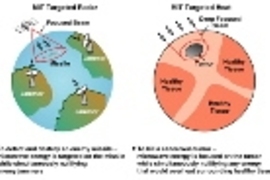A breast cancer treatment based on MIT radar research that was originally intended to detect space-borne missiles is showing promise in the final phase of clinical testing.
Preliminary results to be presented on Wednesday, April 21 at the 9th International Congress on Hyperthermic Oncology in St. Louis show that women with early-stage breast cancer who received the MIT treatment prior to lumpectomy had a 43 percent reduction in the incidence rate of cancer cells found close to the surgical margins. This is important because additional breast surgery and/or radiation therapy are often recommended for patients that have cancer cells close to the edge of the lumpectomy surgical margin.
"One of the primary objectives of this randomized study is to demonstrate that heat can affect and kill early-stage breast cancer cells prior to surgery," said William C. Dooley, director of surgical oncology at the University of Oklahoma Breast Institute and principal investigator of the ongoing study. "With this focused heat treatment, it may be possible for the surgeon to provide better margins for the patient and possibly avoid additional treatment procedures and avoid recurrence of the cancer."
Since October 2002, 90 women with early-stage breast cancer have enrolled in the study, in which microwave energy focused externally on the breast is delivered to tumors prior to lumpectomy. The goal is to use focused heat to kill tumor cells and reduce additional surgery. The current results are based on the 64 women who have completed the study.
Treating cancer with heat is not a new idea, but "researchers were having trouble using it to treat tumors deep within the body," said Alan Fenn, a senior staff member at MIT Lincoln Laboratory and inventor of the technique. Further, it's difficult to deliver the heat only to cancer cells and not overheat normal tissue.
The microwaves in the new technique "heat -- and kill -- cells containing high amounts of water," he said. Cancer cells have a high water content (around 80 percent), while healthy breast tissue contains much less.
The outpatient procedure uses a single tiny needle probe to sense and measure parameters during treatment. Side effects appear to be minimal.
Patients in the thermotherapy group of the current study receive a minimally invasive heat treatment prior to surgery and radiation therapy, while patients in the control group receive surgery alone prior to radiation therapy. Preliminary results indicate that in the thermotherapy group, 5 of 30 (16.7%) patients had tumor cells close to the surgical margins, whereas in the group receiving surgery alone, 10 of 34 (29.4%) patients had tumor cells close to the margin.
The women participating in this ongoing clinical trial are being treated at the University of Oklahoma in Oklahoma City, Harbor-UCLA Medical Center, the Comprehensive Breast Center in Coral Springs, Fla., the Mroz-Baier Breast Care Clinic in Memphis, Tenn., and several other breast centers in the United States.
Previous Phase II, or dose-escalation, results of the breast cancer heat treatment were reported in the February 2004 issue of the Annals of Surgical Oncology. The data for breast cancer patients treated in the dose-escalation trial were submitted to the U.S. Food and Drug Administration, which resulted in FDA approval to proceed with the randomized trial currently underway.
Celsion Corp. exclusively licenses the focused microwave thermotherapy technology from MIT. The company has developed the clinical thermotherapy system and is funding the current clinical studies. The Department of the Air Force funded the original MIT Lincoln Laboratory research by Fenn.







